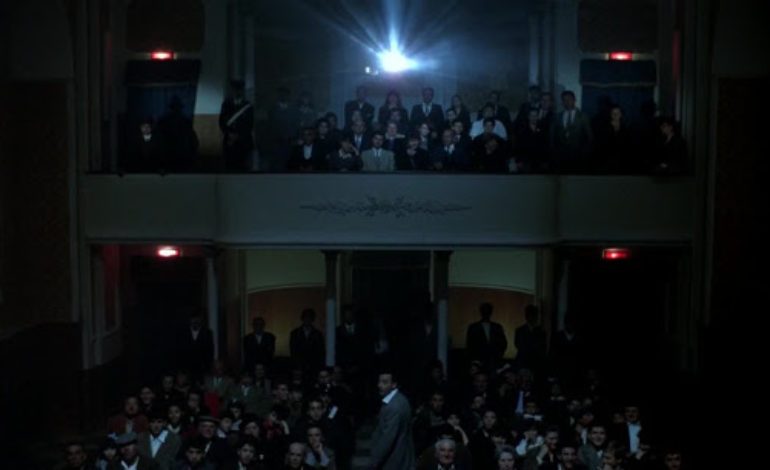

In March of this year, it was reported by Deadline that the biggest of the movie theater chains were furloughing most of their staff in the wake of the coronavirus pandemic. 24,000 of Regal’s 25,000 workers in the United States were furloughed. Similar numbers came from AMC, with 26,000 of its 27,000 being impacted. Cinemark laid off 17,500 of its employees in April. These numbers are from early on in the pandemic, but even as recently as October, it has been reported that nearly 40,000 people working for Regal across the world have been impacted. The language of “strange and uncertain times” has been thrown around a lot, but it is the reality for many movie theatre employees. The question now isn’t when employees will be back, but if they will at all given the current state of the theater industry.
One important thing to note is how the movie industry proper has been impacted. The big spring and summer tent pole films have all been delayed into the next year. Films like Pixar’s Onward, which were in theaters when the lockdown started, quickly moved to streaming services. Other giant blockbusters set to release this year like Black Widow, No Time To Die, and Godzilla vs. Kong have all been moved to the first half of 2021, though time will tell if they get delayed yet again. As of now, Wonder Woman 1984 is still set to release on Christmas this year, but for the most part everything has been delayed or moved to streaming, with all delays having the potential to be pushed further and further depending on how things play out.
Movie theaters are one of the industries hit hardest by the pandemic. Or course just about every business is impacted but theaters are in the situation that they need to be in person to function effectively, but aren’t an essential business like the food service industry so they haven’t been able to open back up in earlier reopening “phases”. Some movie theaters have been given the option to open back up with limited capacity. This however has proven to be an ineffective strategy, especially for smaller chains.


When the theaters are closed entirely, the funding they receive from the government is enough to keep them afloat, at least in my experience with smaller chains. If the theaters are even partially open, they don’t receive this benefit. The bulk of movie theater revenue comes from concessions, as a portion of the ticket sales go towards the studios. A theater only operating with a portion of their usual revenue isn’t stable at all as many theaters were struggling financially before the pandemic. Even as certain theaters open up, some employees have expressed concern for their own health and safety, as well as the theaters being generally understaffed, forcing employees to do a lot more work for only a fraction of the theater’s usual profit. These concerns have expressed at several of the big chains like AMC and Regal.
Another factor that severely hurts the movie theater industry is that it’s actually been struggling for years now. The movie going experience is getting more and more expensive by the year. Ticket prices are going up and concession prices even more so in some cases. As stated previously, concessions are where most theaters make their money. The growing scope and size of studio blockbuster films is also paying a key part. The market has become especially flooded in recent years with huge blockbusters, superhero stories, and a cavalcade of cinematic universes. These films come out at a rapid pace and if a smaller theater only has say fourteen screens, then it’s very hard to keep movies playing as new ones must take their place, making it hard for steady business sometimes. This also makes it virtually impossible for smaller films to get attention when a third of the screens are being used for a single Avengers film.
At the start of quarantine, Universal Pictures released Trolls World Tour as a simultaneous release in theatres and as a digital rental. The film saw great success as a rental, prompting Universal to consider releasing other films in a similar format. This created some bad blood between Universal and AMC Theatres, with the latter company saying it would not distribute Universal films if they continued this practice. The two corporations have since reached an agreement that Universal could distribute the films a few weeks after a run in theaters. This was a very extreme example but it just goes to show that even a titan in the industry like AMC is just on as much thin ice as even the smaller chains and is susceptible to bankruptcy from even some disruption in their revenue.


While certain films like Onward and Trolls World Tour have gone straight to streaming and/or digital rental, Disney has also tried another approach. The live action remake of Mulan premiered on Disney+ as a premium offer. Subscribers could spend 30 dollars to watch and keep the film until early December when it becomes available for all subscribers. This seems to be a bit of an experiment on Disney’s part to see if this is a sustainable model. The fact that their other early 2020 blockbuster, Black Widow, is still planned for a theatrical release seems to imply that this model may not be continued in the future. Audiences don’t seem as willing to spend thirty dollars on a digital copy of a film like that, especially given the tenuous nature of streaming services. See here for more on this dilemma.
The exact fate for movie theaters is still up in the air. This is something that’s already been on many consumer’s minds for a while now. Even industry big names like Steven Spielberg commented years ago that cinemas as we know them might be disappearing before too much longer. As prices continue to rise, more and more people are content to just stream films from the comfort of their home. The pandemic has given many a valid excuse to finally stop seeing movies in theaters and switch entirely over to digital and streaming. The time gap between theatrical and home releases of films had been getting shorter and shorter even before the pandemic.
If theaters do stick around they will likely have to evolve. Drive-ins are doing well again in these times, but those are unlikely to supplant the standard theater experience. Many have proposed that going to the movies in the future will be more of an event, liking going to the opera or a play. It’s a possibility but it likely won’t be sustainable without a tremendous increase in price to match those other art forms.
The best thing movie theaters have going for them are their atmospheres. There is something truly unique about the cinema going experience. I can still remember the collective audience tension of watching Knives Out, or the shared joy and excitement when Captain America began to wield Mjolnir in Avengers Endgame. This isn’t even limited to the crowd experience. As a lifelong Godzilla fan, hearing the titular monster’s roar quite literally shake the room in the IMAX screening of Godzilla: King of the Monsters was something I’ll never forget. These are things that just can’t be done during a home viewing. It may be expensive, but theaters that really invest in enhancing things like sound and image to create a unique and extraordinary experience will guarantee at least some sort of niche going forward.


Ultimately though, it’s all up in the air. The big chains like AMC, Cinemark, and Regal have been struggling to stay afloat and have seen large hits to their stock. If the virus continues to persist for several more months, possibly even multiple years, then some chains may have no choice but to close down permanently. Right now it really just is too early to know. What is certain is that this decline has been a long time coming and theaters need to figure out how to adapt or risk becoming lost to time. Theaters have the potential to create some truly magical moments, and one can only hope that they find a way to continue, even past the current situation.
